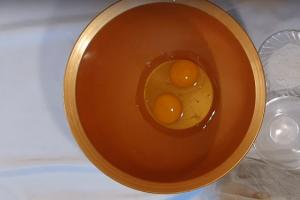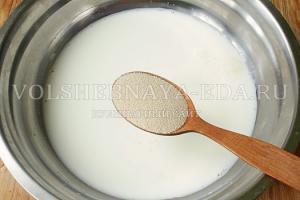Perhaps even casual viewers " Star Wars» will agree that the lightsaber is the most spectacular weapon ever to appear on screen. The combat involving this piece of equipment is so elegant that it has an almost hypnotic power. Well, the message is clear: lightsabers are the deadliest weapons in the universe. And, despite the fact that not everyone has a sufficiently persistent stream of Power flowing through their veins, each of us, deep down in our souls, dreams of seeing ourselves with this instrument in our right hand.
Science fantasy
The idea of a weapon such as a lightsaber is simply brilliant: a lightweight and very powerful weapon that requires only a small dose of energy can defeat representatives of the Dark Side in one blow and become an effective shield against laser flashes.
So why doesn't humanity develop a similar piece of equipment in real life? Of course, to start making these fantastic weapons, it is not enough for physicists to be incredibly smart. Yes, they simply must adore Star Wars.
The obvious way to create such a weapon would involve using a laser, which would appear as particularly bright flashes of light. But even though this technology becomes more and more improved and finds application in mechanical engineering, the luminous sword still remains only a fantasy. Let's look at why. 
Elusive light
The first difficulty arises from the fact that the sword will need to be of an acceptable size. Let's say you settled on a length of about a meter. But to form from laser beam sword, it is necessary to make it “stop” in a certain way. This will be quite a task, since light has a natural tendency to move unless there is an obstacle in front of it.
The optimal solution to this problem may be to place a mirror on the tip of the blade. But just imagine how much inconvenience this design will bring. After all, to install a tiny mirror you will have to use additional parts. It will also make the sword too fragile to use as a weapon. 
Design problems
The second problem is that the developed weapon will consume a lot of energy. But we need exactly the opposite. The blade will require a lot of force to be able to cut certain materials. Welding lasers used in industry are capable of this. But it is worth considering that they are equipped with a huge power supply and incur costs of several kilowatts of energy. In fact, even if you magically manage to overcome this problem, there will be one more “but” standing in the way. The laser device will require a powerful cooling mechanism, otherwise the hot sword handle will simply burn the user’s hand. 
Where would we be without effects?
In addition to this, difficulties will arise in practical application light weapons. First, two laser swords can never collide with each other. They simply pass through each other, without leaving that amazing effect that appears in the films.
Moreover, laser light is focused in a specific direction so quickly that the human eye simply does not have time to catch it. This is why fog is used in nightclubs. Smoke particles flying around the room act as tiny diffusers. They break the laser light into many pieces and thereby make the beams noticeable. 
Plasma as an alternative
But don't despair. No one is saying that a lightsaber must be based on laser technology. Alternative weapons already exist - they are made of plasma. This substance is a hot, literally scorching, gas. Due to intense heating, its atoms disintegrate into individual components, which are electrons and nuclei. 
The most interesting thing is that plasma can emit different colors. The shade of a substance depends on the gas of which it is composed. For example, neon light is the effect of neon converted into a plasma state. The green swords of Jedi Knights can be made from chlorine. But the red light weapons of the Sith villains are easy to create from helium.
What is a plasma sword? A small but quite powerful power supply is hidden in the handle of the weapon. It stretches from him thin thread, surrounded by an inert gas, whose function is to transmit electrical charge. When the sword is turned on, it creates the effect of an incandescent lamp. Electric charge heats gas particles, causing them to turn into plasma. The lamp becomes so hot that it can instantly melt any object.
The ritual of making your own lightsaber was an integral part of Jedi training and included not only technological skill, but also harmony with the Force. Ideally, a Jedi needs many months to create the perfect weapon, which he will keep and use until the end of his days. Once created by you, the lightsaber will be your constant companion, your tool, and your means of defense at the ready.
Luke Skywalker
In this article, a DIYer will tell us how to make a Jedi lightsaber with light and sound effects. Created on the Arduino platform, the sword reacts to every movement. Let's watch the video.
Below are the characteristics of the sword.
Light:
-Smooth on/off with lightsaber effect
- Pulsating color with the ability to turn off
Sounds:
-Mode 1: generated noise. The frequency depends on the angular speed of the blade
-Mode 2: Sound hum from SD card
-Slow swing - long hum sound (random from 4 sounds)
-Quick swing - short hum sound (random from 5 sounds)
-Bright white flash when the sword hits the surface
-Play one of 16 sounds when struck
-Weak blow - short sound
-Hard blow - long sound
-After turning on the power, the blade displays the current battery level from 0 to 100%
Battery:
-The battery is low - the lightsaber does not turn on - the power button flashes 2 times
-When the battery runs out during operation, the sword automatically turns off
Control button:
-Hold-on/off sword
-Triple press - color change
-Five clicks to change sound mode
-Selected color and sound mode stored in memory

Tools and materials:
-
-
-
-
-
-
-
-
-
-
-
-
-
-
-
-You can buy a polycarbonate pipe Ø 32 mm with diffusion (dispersion);
-Sewer pipe Ø 32 mm and Ø 40 mm;
-Plastic plugs;
-Everything for soldering;
-Plume;
-Steel wire;
-Double-sided tape;
-Glue gun;
- Fasteners;
-Hacksaw;
-File;
-Ruler;
-Marker;
-Knife;
-Scotch;
-Paper;
-Burner;
-Drill;
-Calipers;
-Cone drill;
-Spray paint;
-Foam rubber;
-Heat shrink;
-Insulating tape;
-Screwdriver;

Step one: connection
According to the diagram on breadboard collects electronics. Solders the contacts with a mounting wire. The buck converter pre-regulates to 4.5 V. The accelerometer is connected separately using a cable.







Step two: firmware
Instructions, firmware, sounds can be taken
or download from the link on this page.
You can configure:
-The number of chips on the tape (if the length of the sword blade changes)
-On/off flicker
-Measure and indicate the resistance of resistors in Ohms
And some other settings.
For the project, the master took MicroSD 4 GB, FAT.
When flashing the assembled sword, you must turn on the power.

Step Three: Batteries
For his project the master used three lithium batteries 18650 with built-in protection.
Solders them in series into one battery. The diameter of the 32 pipe is larger than the battery pack. The author wraps the battery with paper so that it fits tightly into the pipe. Then he heats the surface of the pipe with a burner and quickly cools it. The pipe tapers and takes the shape of a battery. He takes out the battery. He takes off the paper. Now the battery fits tightly into the pipe and does not dangle.








Step Four: LED Strip
Blade length (polycarbonate pipe) 75 cm. The master cuts two pieces LED strip 75 cm each. Place double-sided tape on the tape. Makes a hole in the top of the tape (without damaging the tracks). Pulls one end of the insulated wire into the hole. Glues the wire to the tape along the entire length of the tape. Glue a second strip of tape on top. The result is a rigid LED design.







Having previously brought the cable out, it secures the accelerometer in the second (lower) plug. Solders the wires to the LED strip and leads them out. Secure the wire with a self-tapping screw to the plug. To prevent the tape from dangling in the middle of the tape, use a toothpick to make a transverse stop. Places the polypropylene tube on the bottom plug. Puts on the top cap. Pulls the wire and secures it with a self-tapping screw at the top.






Step five: handle
For the handle, the master used two pieces of pipe, Ø 32 mm and Ø 40 mm, inserted into each other.





Drills holes in the handle for the connector, the power button, the mode selection button and a number of holes in the lower handle of the part for the speaker. Covers the handle with paint.
Back in 1976, the first creation of George Lucas appeared on the screens - the beginning of the Star Wars saga. The author's fantastic idea captured the hearts of people who became ardent fans of the film. Every girl dreamed of being like Princess Leia, and boys imitated the heroic warriors. We invite you to make a Jedi sword with your own hands. It would make a great toy for a little fan or complement the role play of an adult Star Wars fan.
Sword from a lantern
In order to create Jedi swords for children, you need to choose safe materials. Most suitable option— make a toy weapon from a simple flashlight. It should fit comfortably in the baby's hand. It's better to choose lighting fixture, inside of which there are diodes. They are durable and consume minimal energy, so you won't need to change batteries often. Make sure the flashlight produces colored light. If you don’t find one, don’t be upset: you can remove the glass and paint the diode in the desired shade with ordinary nail polish.
Second integral part The toy sword consists of a polycarbonate tube and a small plastic plug. Adjust the length of the blade yourself by trying it on with your child. 60-80 cm will be enough. The cross-section of the pipe should be slightly smaller than that of the flashlight. You will also need hot glue or transparent “Moment” and electrical tape.
Assembling the toy
Assembling a formidable laser sword is quite simple. First, prepare the blade. Polycarbonate is transparent, and you need a material that will diffuse the rays. To make the tube matte, go over it carefully sandpaper. Using hot glue, attach the cap to the top of the blade. Remove the glass from the flashlight and fit the tube to the handle. If it does not fit tightly inside, make several turns of electrical tape. Secure the blade with glue to the top of the lantern. All that remains is to check the toy in operation. Your child will jump with happiness! Create Jedi swords for his friends, and they can play against the forces of evil.

Such a weapon, made with your own hands, will cost you little (unlike offers in toy stores, where the price is very steep), and you will spend a minimum of time on its manufacture.
LED strip sword
To make a lightsaber you will need:
- LED strip, or It has a lot of advantages, including safety, durability and low energy consumption. The price depends on the width of the tape and the number of diodes. On average, it ranges from 350 to 500 rubles per meter. A wide range of glow shades will make it easy to determine the color of radiation that your Jedi swords will emit.
- Metal lantern. You do not need this device as an illuminator; it will serve as a reliable handle for a formidable weapon. When choosing, rely on color, design, size. It is important that the handle fits comfortably in the palm of your hand, and that the inverter easily fits into the inner tube.
- A tube. As in the previous version, use a piece of polycarbonate treated with sandpaper. Make sure there is a plug at the end.
- Inverter. This is a special battery for flexible neon. There are button batteries inserted inside a small box.
In addition, you will need hot or instant glue and electrical tape.
Preparatory part
Now let's look in more detail at how to make a Jedi sword. First you have to “gut” the flashlight. Carefully remove the insides. See if the inverter fits inside the tube. If yes, then everything is great!
Remember that the cross-section of the tube should be slightly smaller than that of the top of the lantern. Choose the blade size yourself. Sand the ends of the plastic with sandpaper, as it is very easy to cut yourself on them.

Assembly
The size should be slightly larger than the tube. Use hot glue to secure one end to the cap that will cover the top of the weapon. The tape should be inside the polycarbonate tube. Jedi swords glow evenly along their entire length; cold neon will give you this effect.
To connect the tape to the inverter, you just need to insert the connectors into each other. No soldering or additional manipulations are required, which is very convenient. Check the lighting operation.
To ensure that the sword serves you for a long time, carefully fix the inverter inside the tube using hot glue. This way it will not dangle and hit the walls of the case.
All that remains is to carefully insert the tube into the base of the handle and secure it with glue. The lightsaber is ready! This option is suitable for both role-players and children.

To those on the dark side
Fans of insidious images also need Jedi swords. After all, the Sith simply switched over and created their own order. Darth Maul wielded dual weapons, which provided an element of surprise in battle. His red lightsaber frightened everyone who came across the dark lord on the way.

As you may have guessed, it will not be difficult to make. You just need to collect two swords with a red neon ribbon. Please note that their blades should be slightly shorter. Connect the flashlight handles together using black electrical tape. Make the winding strong so that the parts do not dangle. You can first fix their bases" second glue", and then go over it with black insulating tape.
Conclusion
Now you know how to make a Jedi sword with your own hands. Real fans turn metal hilt parts on lathes.

They use special compounds to treat steel to achieve a realistic effect. Thanks to the assembly process described in the article, you can continue on your journey to making formidable weapons to protect the universe.
If you are a Star Wars fan, then you simply need to get your own. There is no need to buy it at all, since this “weapon” can be made independently from parts that are very easy to get. The photo report and instructions that await you below will tell you how to make a lightsaber with your own hands.
We buy these diodes in quantities of 110 pieces.

We solder in parallel (here the solder is divided into 4 parts).

The division into 4 parts is made so that you can connect all 110 diodes to 4 batteries with a power of 3.6V each. 350mA driver.

Since a strip of 110 diodes is divided into 4 parts, then each part (~26 diodes) carries 350mA. 14ma for each diode. Chrome plated steel cylinder with a diameter of 30mm and a length of 250mm. It will hide batteries and wires.

The blade itself is a polycarbonate tube with a diameter of 30mm, a wall thickness of 2.5mm and a length of 1000mm.

A white packaging film and diode strip are placed inside this tube.

The bottom cover is printed on a 3D printer, where the power button will be located.

Hello everyone!) A lightsaber is an integral attribute of the Star Wars films, a cult craft that every person who calls himself a Star Wars fan and a follower of Obi-Wan Kenobi should have...
For years I wanted to get my hands on the "original" lightsaber. However, the industrial designs that were presented on the market did not meet the requirements I had stated (I didn’t even want to take on a plastic likeness of the majestic artifact). So I had an idea do their hands a sword that would suit my desires and look unsurpassed.

In the article we will consider in detail how and from what parts it will be possible to make this homemade.

Some of the parts used can be replaced with plastic pipes, but then the parts will lose some of their strength and the effect of realism will be reduced.

This sword glows and changes colors (no light or sound effects). With the right skill set, you can easily add additional functions into this product.
Step 1: Required Materials and Tools

I want to immediately dot all the “E”s, I am not a plumber or a seller of plumbing products, so the names below may be incorrect.
- 32 inch (81.28 cm) long clear plastic pipe;
- Inch metal pipe;

- Inch connector detachable coupling;

- LED RGB strip;

- Two inch straight couplings;
- Selector switch (we only need a nut)

- A washer that needs to be secured to the selector switch nut.

- Inch squeegee

- Wax paper

- Long wooden dowel approximately 3/4" in diameter and 32" long.
- Super glue, epoxy resin, silicone glue.
- Engraver, soldering iron, drill, hammer and set of precision screwdrivers.
- Small switch
- A small 3-position switch that will be used to change the color of the blade's glow.

- 9-volt battery with connector and soldered leads.

- The main resource is patience!
Step 2: Assembling the battery holder (top)

Using glue, we attach the straight coupling, the nut from the selector switch and the washer together.
Since the power source is a 9-volt battery, it is necessary to find a way to secure and hide it in the hilt of the sword.
Unfortunately, the inch pipe is too narrow to fit, but the inch coupling fits just right. To prevent the battery from falling out and not “damage” the battery itself, we secure the nut and washer (after gluing them with glue) to one end of the coupling.
Once the glue has dried, check the quality of the seam and, if necessary, glue everything again.
Step 3: Assembling the guard

We disassemble the split coupling and select the part that we like best.

We twist together: part of the split coupling, the bend and the straight coupling.
Step 4: Handle

Let's take an inch pipe and cut a piece of any length (the main thing is that you feel comfortable) taking into account the fact that you will need to attach the guard and pommel to it.
Step 5: Blade

Let's take a polycarbonate tube and install it in the guard. Leave space in the guard for switches.
The copper wire will not only help securely secure the blade, but will also make the sword stand out thanks to its own unique design.

After installing the blade tube, we will drill through holes the same diameter as copper wire. Let's cut it into small pieces and then mount it as shown in the photo. Then use super glue to securely fix it.
Step 6:

Step 7: Prepare the guard for installing the switch

First, decide where you want to place the switch or switches. Since I wanted the sword to glow in different colors, I had to install two different switches. One is power, the second is color switching.
Let's install switches at the top of the guard so that the copper wires protect them in the heat of battle.
I drilled, cut and sharpened the guard, getting two large enough holes to fit the switches.
We don’t secure them yet, otherwise we won’t be able to connect the wires to the LEDs.
Step 8: LEDs and Dowel

Take a strip of LEDs and cut a section about twice as long as the intended length of the lightsaber blade (make sure you cut the strip at right place- along the cutting line).
The strips should have a 4 color pinout pinout attached to one end (most likely red, green, blue and white).
Let's strip the ends of the wires. We hold the white wire on the positive terminal of the battery, and the remaining wires (individually or all at once) on the negative terminal.
Let's fold the strip of LEDs in half and pass it along the blade. Then place a wooden dowel in plastic pipe. The tape will be sandwiched between the pipe and the dowel.
Let's pass the wires through the guard and solder them where necessary. Let's secure the switches.
Step 9: Final Touches

Finally, we’ll add a diffuser to diffuse the light from the LED strip.
It would be possible to paint the blade with white paint.... but I decided to save great view and just used wax paper.
Let's twist a tube of paper of sufficient width and length so that it fills the tube and slides along inside blade around the double-sided LED strip.
It will take a little effort, but in the end you will get great results.
I filled the top of the blade with silicone to seal the plastic tube.
May the force be with you.








